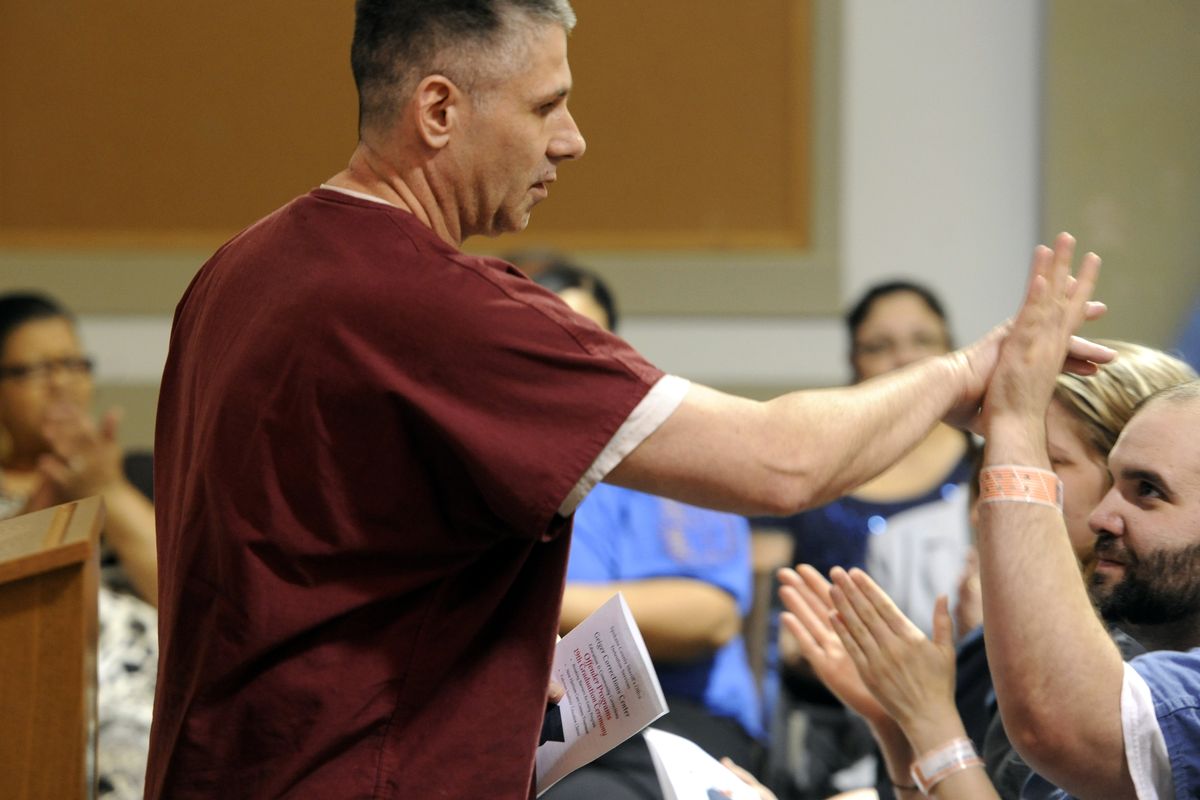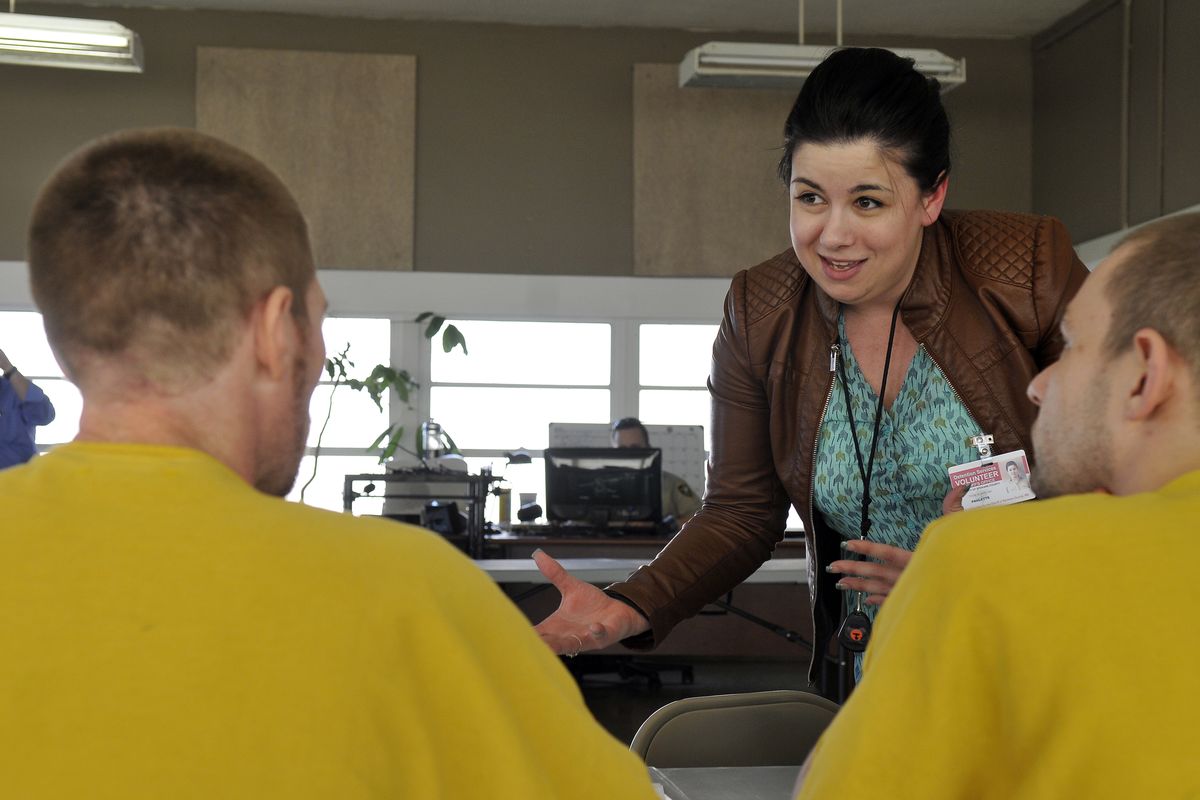Authorities try to close criminals’ revolving door of trouble
Mark Bliven, left, high-fives Chuck Bliss on Thursday after making a short speech about how his life has been affected by classes at Geiger Correctional Facility. The county lockup offers counseling and life skills classes through the Fulcrum Institute. (Jesse Tinsley)Buy a print of this photo
Think of DaShawn Jordan as one of the hundreds of young people in Spokane whose life has veered into a culture of drugs and guns and the revolving door of the criminal justice system.
Jordan, 37, wants out.
“I made a lot of bad decisions in my life. I don’t think of myself as a bad person,” he said.
With only a couple months left on his sentence, Jordan has immersed himself in a series of new treatment programs at Geiger Corrections Center in an effort to change his life.
Spokane officials increasingly are reaching out to low- and medium-risk offenders like Jordan to help them avoid another stay behind bars, at the same time making Spokane safer and containing the rising costs of criminal justice.
Jordan, who grew up in northeast Spokane and attended Rogers High School, said his troubles worsened when his brother was shot and killed in a robbery in 2002. Drugs filled the void but eventually landed him back in custody.
Now, he said, he’s become a minister and wants to counsel people with similar problems. “My life is based on what’s happening from here on out,” he said.
Late last month, a dozen prisoners gathered at the Geiger facility for a five-week class called “Discovering Emotions,” where teacher Rachelle Mattingly-Gore showed them ways to stay in control of their emotions. It is one in a series of classes offered at Geiger by the Fulcrum Institute of Spokane.
Mattingly-Gore said she believes people who are locked up aren’t much different from those on the outside. “I think we are all just a few bad decisions from being here,” she said.
‘Off the street’
Spokane County Sheriff Ozzie Knezovich has another view.
He said the Spokane area has too many criminals who don’t want to change, and many of those are so dangerous that they need to be locked away.
Like many law officers in the Spokane area, the sheriff is frustrated by rising crime and the system’s inability to hold offenders accountable.
“The repeat offender has to be taken off the street,” he said.
But within the broad group of people who get arrested, Knezovich said, many offenders have decided that it’s time to change ways. The corrections system should offer help, notably in cases involving drug and alcohol addiction, and mental illness, he said.
Knezovich argues that moderate sentences of six to 18 months are needed so that treatment has time to work. The addict’s brain needs time away from drugs and alcohol to make lasting changes, he said.
“It’s a balanced approach,” he said of his view toward sentencing and treatment. “It’s not one or the other.”
Cost savings
Statistics gathered by the Washington State Institute for Public Policy show that treatment programs around the country produce positive results. Some are surprisingly inexpensive.
Cognitive behavioral therapy – the kind offered at Geiger – might cost $412 an inmate, but could result in $9,700 in savings in avoided costs of future crime, according to a 2012 analysis by the nonpartisan, nonprofit institute.
Employment training and job placement are other examples. It might cost $135 to get an inmate ready to work, but the training potentially yields $5,500 in avoided costs of future crimes.
Corrections officials and providers say the data is helpful in designing what they call “evidence-based programs,” including drug and alcohol treatment.
“What we are trying to do is stop that revolving door,” said Judith Gilmore, of the Fulcrum Institute. “It costs us all a lot less if we get them on the right track.
“The beauty of it is we are seeing a change,” she said.
Road to recovery
Fulcrum, which has offered dispute resolution and family services in Spokane for years, got involved in crime treatment in the past year after plugging into a series of grants, including one from Women Helping Women and another through Spokane Neighborhood Action Partners.
Fulcrum has created a business roundtable with more than 200 employers so that released prisoners can get job referrals and interviews. So far, they have a 50 percent placement rate, Gilmore said.
A post-release mentoring program, though new, has yet to see any of its 51 participants get arrested again. The program helps offenders with housing, job training, bus transportation, family support, mental health counseling, and even clothing and household supplies.
Adam Myers, 30, is a recovering heroin addict working his way back from years of crime and drugs. His trouble started after his alcoholic mother put him into foster care because she wanted to “erase” him from her life, he said.
“Taken away from everything you know, you run from your problems,” he said.
At one point, Myers said he lost his son to sudden infant death syndrome, a loss that sent him spiraling downward and back to prison. He was working his recovery in his son’s memory at first but has since discovered that it is really about saving himself, he said.
Myers said his Fulcrum mentor, a fellow former convict, taught him the most important thing: “If you don’t believe in yourself, you can’t do anything.”
Many forms of reform
In recent months, government leaders from agencies throughout the region have stepped up efforts to get control of accelerating crime, especially the high numbers of property crimes.
The Spokane Regional Criminal Justice Commission is expected to make reform recommendations this fall.
Law enforcement, prosecutors and judges have been moving toward alternative sentencing for lower-risk offenders, such as electronic home monitoring, work release, community service and day reporting.
Spokane’s city crime rate is up 11 percent so far this year. At the same time, annual crime statistics from 2011 – the most recent available – show that Spokane has double the statewide rate at 78 crimes per 1,000 residents.
Knezovich said the problem spills into other cities and local unincorporated areas. He and other top law officers earlier this month announced a new property crime task force to target repeat offenders and troubled neighborhoods.
At the same time, the Spokane County Jail has been at capacity since the beginning of 2013, with the number rising to 950 inmates or more at times.
Knezovich said half of those inmates are being held for violent crimes and only 140 for misdemeanors.
The move toward criminal justice reform and new treatment programs comes with the backdrop of discussion on replacing the existing jail with a more efficient facility.
Officials are trying to trim what was a $200 million proposal two years ago to a $100 million plan to allow for a modest expansion of capacity, and then add space in later phases.
‘Address the underlying issues’
Lt. Joanne Lake, assistant commander at Geiger, said a key to managing offenders starts with individual assessments of risks and needs and whether they are candidates for treatment or jail alternatives.
“It needs to be an offender-based system,” she said. “Right now, it’s a crime-based system.”
Electronic home monitoring may be a good choice for some, but in many cases “just putting an ankle bracelet on them” isn’t going to solve underlying problems, Lake said.
“The vast majority of them need the timeout” of being incarcerated, she said. “If you don’t address the underlying issues, they are going to come back to the system.”
Lake acknowledges that she prefers a corrections approach over a punishment model. “From my perspective, I think we are better off if we invest in change and hope.”
During a graduation for program participants last week, Knezovich warned the inmates that they don’t want to turn 50 behind bars and look back at spending half their lives away from their kids, their partners and a normal life.
After the sheriff finished, inmate Robert Howley, 50, stood and said he is one those people. “There’s a reason you are here,” he told fellow inmates. “It’s a life of blaming others.
“I thought I was so damn good and jail was just a part of it,” he said. “It’s not cool.”

